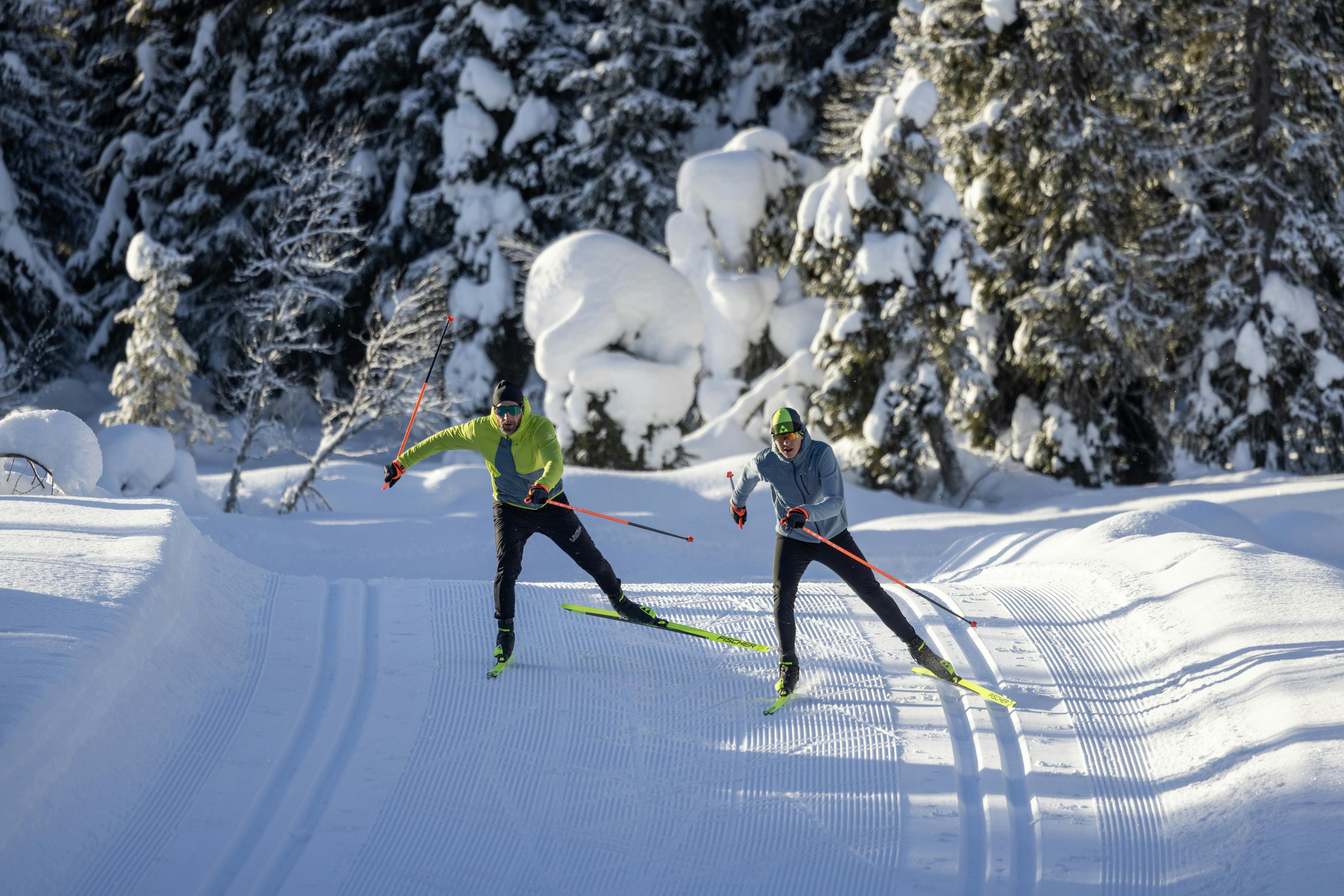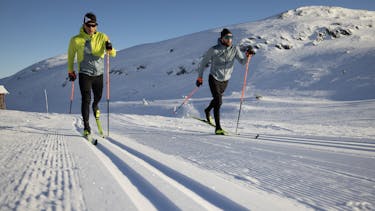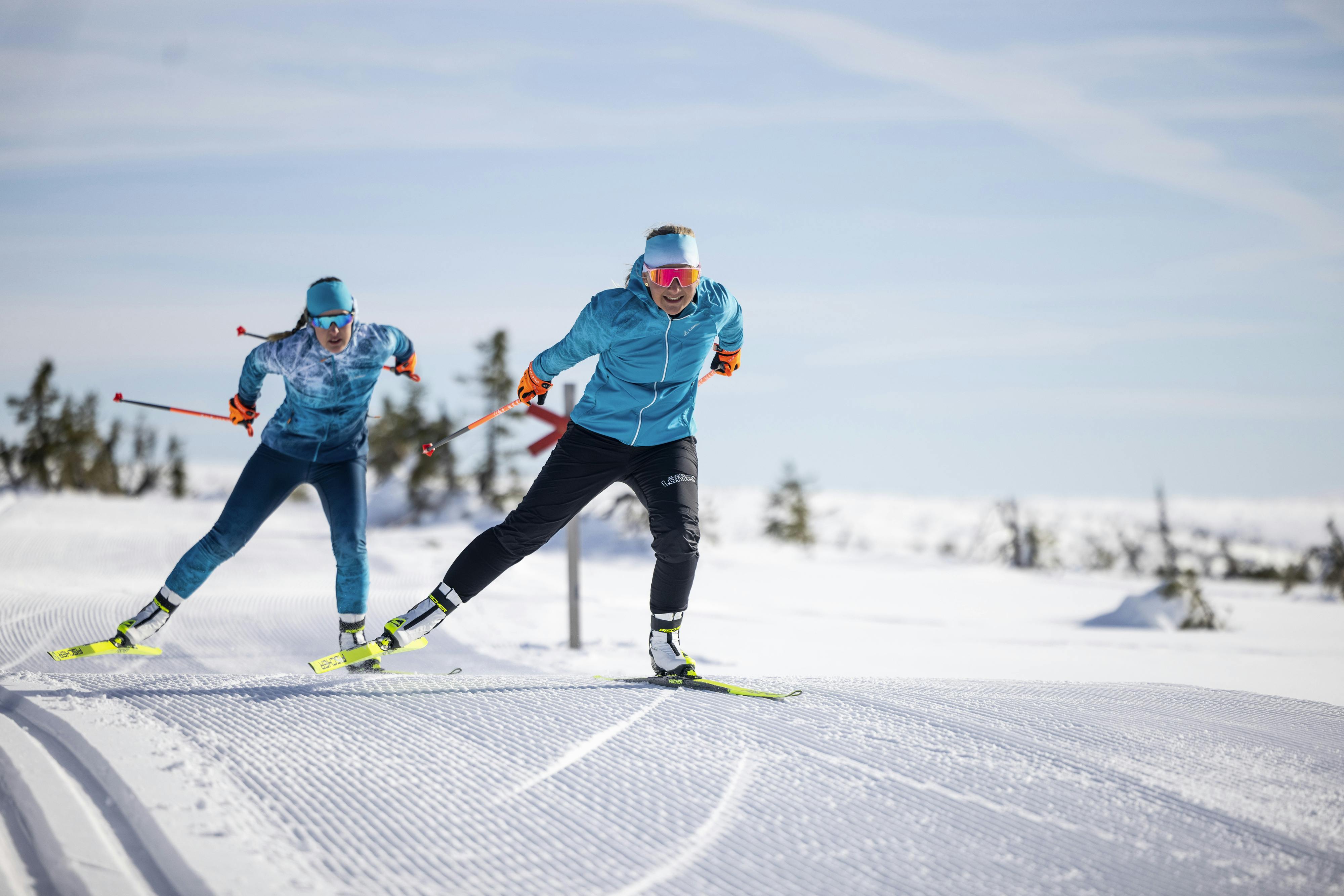A fun sport that lets you relax out in the best that nature has to offer is also a big positive. We hope this is the season that you, too, give it a try. We’ll help you get started.
For beginners
There are two separate styles of cross-country skiing: Classic skiing and Skate skiing. The idea of efficient forward motion through the snow is, of course, the same for both, but the techniques and equipment are different.
Most beginners start with Classic technique. It is simply less complex and easier to pick up quickly. Many skiers will then learn the Skate technique and enjoy the benefits of both.

Classic technique
As the name suggests, this is the original style of cross-country skiing and the one first featured in the Winter Olympics, in 1924. It typically takes place on a prepared track through forests and fields.
The motion of the legs and the arms is all in a linear, or fore-and-aft, direction. The legs scissor as one pushes off while the other glides. The arms provide further forward thrust by driving ski poles into the snow along either side of the skier. When a burst of speed or power is needed, both poles are used simultaneously for drive, while the legs remain together for glide and balance.
The skiing motion of the legs is essentially the same as walking. One leg pushing off as the other moves forward. In skiing there is the friction of the snow under your ski, but good skis, using specialized wax, reduce that as much as possible.
The arms provide additional drive, taking turns to complement the action of the legs by pushing off on the opposite side of the body. Like walking or running, the arms move forward or backward directly opposite the direction of the legs.
Cross-country skiing is at its most efficient and most enjoyable when a skier has developed good balance and achieves consistent, strong technique and rhythm. Take the time to learn proper technique and the payoff later will be well worth it.

Skate technique
Skate skiing uses the same basic actions as inline skating or ice skating, with poles providing extra drive. The skate technique and specialized skate skis were added to the Winter Olympics in the 1970’s. Winter biathletes use this technique exclusively- primarily because it makes it easier to assume a prone shooting position. It typically takes place a smooth, prepared trail. The lateral movements are slightly more complex, so be patient as you learn it.
1. Start out on a flat, well maintained trail. Visualize the actions before you begin.
2. Put away your poles at first and focus on the leg movements.
3. Place your skis in a shallow V position, tails towards each other.
4. Shift your weight onto one leg, which will be the glide leg, and push off at an angle with the inner edge of the other ski. The easier the terrain, the less of an angle your skis will need.
5. After you have a bit of forward momentum, the movements will become easier. Alternate sides for push-off and gliding. Keep the upper body relaxed, without excessive movement.
6. After you have a feel for the technique, use your poles. Bend your arms slightly and use both poles at once, pushing them into the snow around the level of your bindings, then seek a fast smooth rhythm of poling and skating.

Braking
- Be sure to practice your braking technique before you’ve built up too much speed. Use the same “snowplow” method as a beginning Alpine skier until your skill level increases and you can master other braking methods.
- Just flare out the tails of your skis as you bring the tips closer together and dip the inner edges down. Squat slightly to bring more force to bear, and keep your hands at hip level, with the poles pointed backward, for a low center of gravity.
- Beginning cross-country skiers need to smile and accept the fact that sometimes it’s too late for controlled braking so they need to master the controlled crash method.
- If you’re a little out of control and going too fast to avoid obstacles or other skiers, learn to sit back and let your rear hit the ground and slide to a stop that way. Diving forward or to the side in that situation is too risky because you can get tangled in your own skis and put those around you at risk.

Gear
- Skis, poles, and boots are typically available for rent at any resort or winter sports retailer. One of the advantages of renting is that the skis will already be properly waxed, so you can head right to the track for Classic skiing or to the open trail for Skate skiing.
- Keep in mind that cross-country skiing is not at all comparable to Alpine skiing as far as physical effort. Even at a relaxing pace you’ll build up body heat and start to sweat, so dress appropriately. You need authentic winter sports gear that protects you from the wind and snow, while also letting heat and sweat efficiently evaporate.
- Consider the amount of arm and leg movement involved in either style of cross-country skiing and be sure the fit and stretch of your apparel are sufficient.
- Sports apparel technology, including the use of natural fibers, is now so advanced that there is a nearly unlimited selection of gear at affordable prices.
Tracks and trails
With the increase in popularity, beginner course are almost always available at larger ski resorts. Of course, you don’t need to be in the mountains for good cross-country facilities. There are numerous excellent skiing areas established in flat, low-lying areas.
Learn to cross-country ski in... Austria
The absolute hub of all things cross-country is the winter sports capital city of Seefeld, in the state of Tyrolia, who calls itself the most beautiful high plateau in the Alps. There are over 254 kilometers (158mi) of tracks and trails there for all ability levels.
... in Germany
The beautiful Black Forest region is especially renowned for its variety of high quality cross-country trails for pro’s and beginners alike.
Other excellent recommendations include the Allgäu region in southwest Bavaria, the Oberbayern (Upper Bavaria) district around Munich, the Bavarian Forest area to the east, and the area of the Harz mountain range in north central Germany.
...Switzerland
...where they are proud to claim over 5,500km (3,418mi) of cross-country ski trails.
Behind the scenes
Cross-country skiing is also extremely popular in Scandinavia, where it in fact originated as a basic means for people to navigate the winter terrain. A ski has been discovered in Sweden that dates to around 2500 B.C.
The first races took place in Norway In the 19th century, with the sport gradually taking hold in the German-speaking areas of Europe as Danish students came south to study.



